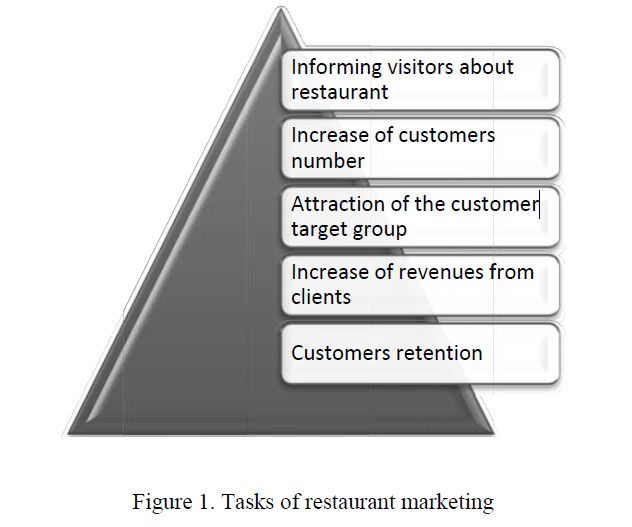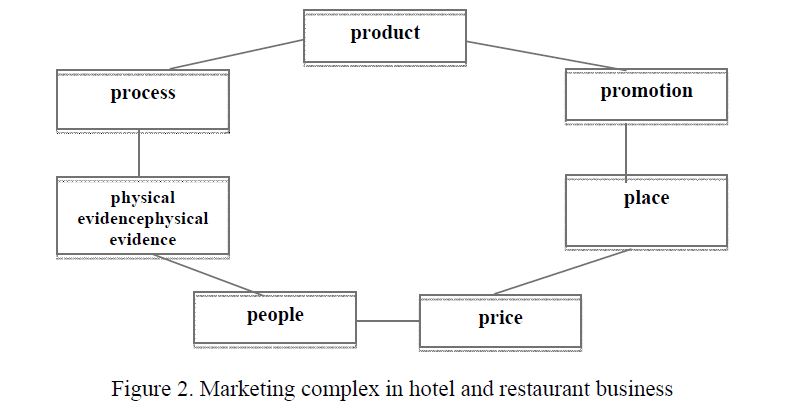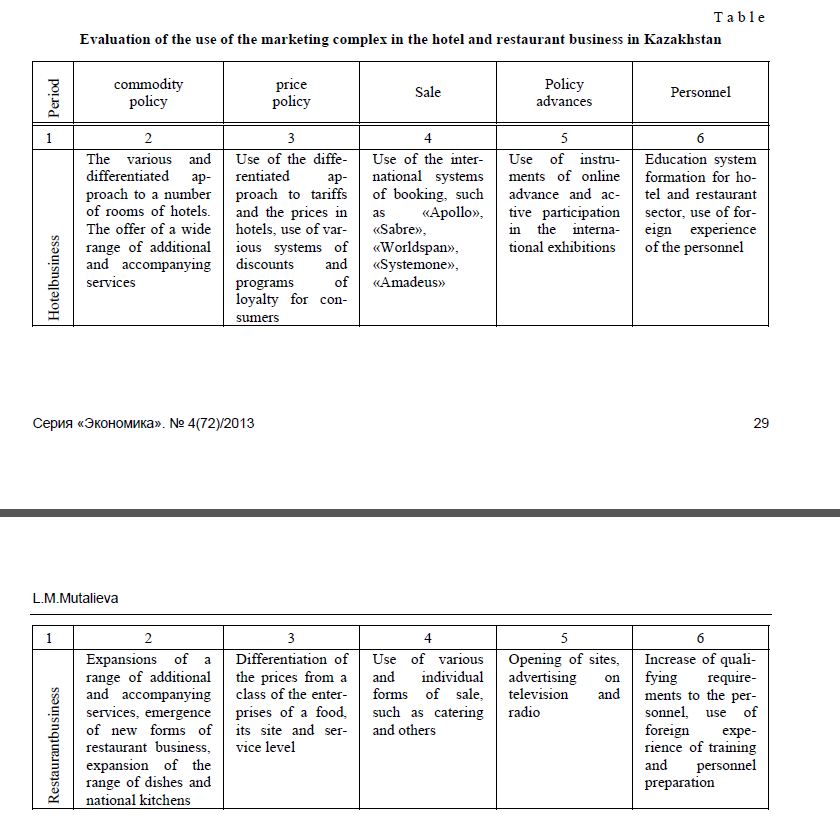The paper addresses issues of importance of marketing in the hospitality business. This is a necessary condition for development of the industry, which allows to solve problems and create favorable conditions for the operation of both domestic and international tourism. The main problems, strengths, and weaknesses of the marketing of hotels and restaurants in Kazakhstan; in general, the purpose and objectives of restaurant marketing are determined. The features of the marketing mix in the hotel and restaurant business in Kazakhstan are revealed. Particular attention is paid to the influence of tourism on the hospitality market. At the present stage in the crisis issues concerning what should be the product of a hotel and restaurant services become topical. For the development of the hospitality industry is the formation of a highly important to the tourism industry. The article noted the difference between network marketing and domestic hotels, identified areas of marketing hotels and restaurants.
Due to rapid development of hotel and restaurant market, expanding their spheres of activity it is needed to use marketing tools. In this regard, marketing has become an important tool for hotels and restaurants, to improve their competitiveness and increase market share. More and more effort is directed to the construction and promotion of brands in order to gain the consumers on an emotional level, forming a circle of constant and loyal customers. A successful approach to the use of marketing tools in hotels and restaurants can not only fix in their minds a positive experience and to raise awareness of the services provided, but also to increase profits, the market capitalization of the company.
Restaurant marketing is a special sphere of marketing, taking into account features, capabilities, and management needs of the restaurant business, aimed at creating added value for the consumer of restaurant products.
The purpose of restaurant marketing is to do everything possible to ensure that guests, once visited this restaurant, came again and brought their friends and acquaintances.
For example, Figure 1 shows the problem of restaurant marketing.

Figure 1. Tasks of restaurant marketing
First of all, informing visitors about the restaurant refers to the initial stage of the restaurant when it is necessary to inform potential customers about the opening of a new restaurant. Special cases a ethe change in the concept of the restaurant and the other is so strong changes, thus in the eyes of former clients he is perceived as another restaurant.
By expanding the range of visitors is meant to attract an audience that is not quite peculiar to this institution. However, it should be noted that the intersection of the different types of visitors can have a negative impact on the image of the restaurant. For example, if the interests of the involved segment of a new conflict with the interests of the existing audience, the company may lose key customers. For this reason, you must either separate streams of visitors or to attract people from related categories that are similar in their behavior publicly available. To do this, follow very closely both the restaurant market and the changing preferences of the target audience.
Talking about bringing different people by separating the flow of visitors, it should be noted that it can be done in two ways.
The first is to attract visitors to the banquet services. This category of users is not always the same as the target audience for the restaurant, but you can distribute the flow of time. On weekends, many restaurants, including the city center, are experiencing significant disadvantage of customers. In those days, you can take orders for banquet service, or else arrange family brunches.
The second method for the separation of visitors flows — work in multiple formats. For example, the cafe is open during the day under the scheme transfer line, and in the evening — in the format of a cafe with service. It can bring a positive effect, as the public, visiting institution in the afternoon and evening, different. The same applies to the cafe in the business centers. It is obvious that during the day people use it as a dining room, and in the evening — as a holiday destination.
Planning a target group of visitors is to the development stage concept of the restaurant. The concept is based on market research, in which the target audience is defined. Also under development concepts are determined by the parameters of the concept institution capable of attracting the target group, as well as those that will cut off unwanted audience. The package of measures designed to attract the target group and cut off unwanted public, is follows:
- A well-planned advertising campaign, which clearly reflects the image of the restaurant;
- Location;
- Price category of the restaurant;
- Kitchen;
- Service;
- The facade design, signage, entrance and interior;
- Services provided by the restaurant [1].
Given the characteristics of the behavior of a selected segment of consumers, it is necessary to develop a set of marketing. In services, it can be defined as «7P»: product, promotion, place, price, people, physical evidence, process [2]. Marketing mix in the restaurant business is presented in Figure 2.

Figure 2. Marketing complex in hotel and restaurant business
The product should meet the needs of the consumer, the promotion includes the sale, holding a trading company, advertising, public relations, publicity, image creation, symbols, awareness. Location determines the consumer's access to products and services, and the price should be commensurate with the value for the consumer. People play an extremely important role in the restaurant business, what caused the importance of proper selection, training and motivation. Ideally, the restaurant staff is to be courteous, responsive, proactive, friendly, able to make decisions that are competent. Material evidence — is that the institution has to offer: beautiful interior, design, speed of service, quality of service.
In order to determine the level of development and use of marketing consider the application of marketing in the marketing mix on pricing, product, marketing, communications and human resources policy of the company (Table).
T a b l e
Evaluation of the use of the marketing complex in the hotel and restaurant business in Kazakhstan

As can be seen from Table, the formation of marketing in a market economy in the restaurant and hotel business contributed to the development of these areas of activity and differentiation of demand, which subsequently led to the emergence of new forms of service.
Overall, the analysis of hotel catering business has shown that in these industries there is a number of disadvantages, destabilizing their activities:
- Lowhotels and catering load:
- Not-matching price level of service and quality of hotels catering;
- Discrepancy with international standards of service quality and level of service;
- Weak system of training in the hospitality business;
- Lack of signature dishes in many catering;
- Narrow range of dishes catering enterprises;
- Low level of development of Internet, used by guests in the hotels;
- Low level of comfort in domestic
The main tasks of defining the marketing activities in the hotel and restaurant industry:
- Increase of capacity of hotels and restaurants, realizing other basic and additional services (business center, restaurants, bars, );
- Analysis of pricing, marketing, advertising, business strategy and methods of sales promotion, identifying their strengths and weaknesses;
- Development and the formation of short-, medium-and long-term forecasts sales service of hotel;
- Selection of the most promising target market segments and development of strategies focused on them;
- Development and the formation of corporate identity, its proper use in the design of internal and external premises of hotels and restaurants;
- Formation of a marketing plan, and accordingly events for advertising and public relations;
- Developing a clear and consistent with the requirements of the market positioning of the program and compliance of the marketing complex of the program;
- Informing consumers through advertising and the media on the indicators of positioning of the hotel and restaurant;
- Development of proposals for the formation of positive image and adjusting the hotel and restaurant in the minds of consumers [3].
At the present stage in the crisis conditions become topical issues concerning what should be the product of a hotel and restaurant services. A survey by the Kazakhstani Hotel and Restaurant Association showed that on the first place from the point of view of consumers is a measure of comfort, on the second place, respectively, cleanliness is important; then effective and practical hotel rooms, and also an important touch to the national culture and way of life and less important indicator — the quality of services provided.
The hotel market still has great potential for growth, as evidenced by lack of supply and demand due to the lack of quality projects that are updated in a growing number of foreign tourists in Kazakhstan. So, only in the city of Almaty, recently put into operation, such as a hotel network «RixosAlmaty», «HolidayInn», soon to be launched following hotels «BayterekKempinski» (236 rooms), «Radisson SAS Medeo» (150 rooms), «JWMarriottHotelAlmatyEsentaiPark» (175 rooms), «RoyalTulipAlmaty» (166 rooms), GoldenHills.
Despite the general economic crisis, the demand from hotels Almaty is high enough, so the hotels practically did not dump prices, but the extensively used the discount.
The most adapted to the crisis, will be hotels implemented taking into account market realities that did not overestimate the cost of entry and land and have a partner — hotel operator with a strong brand.
As the analysis of the development of the hotel market, at the moment there is a high demand for midrange hotels that meet international standards. In particular, there is a need in the segment of three-star hotels with a price tag of around $60–65. Confirmation to the above is that the three-star hotel «HolidayInn» has a high load.
Importance for the development of the hotel and restaurant is to business formation of a highly tourism industry. In Kazakhstan, in this regard are implemented new prospective tourist projects of international importance, namely, « Jana Ile», «Burabai «, « Kenderli», the construction of a tourist complex with the entertainment industry outside of Baikonur (creation of the planetarium, a museum, a minimission control center, shopping center selling souvenirs), the development of infrastructure in the Kazakhstan segment of the Great Silk Road.
The main tourist products that may be offered by Kazakhstan: beach tourism on the Caspian Sea, business tourism, wildlife tours (ecotourism, safari steppe), Baikonur.
Kazakhstan also plans to implement an attractive tourism projects that improve the occupancy of hotels and restaurants. These projects include: the creation of Tourist Center in Akmola and Almaty regions, the development of tourism along the Silk Road, beach and cruise tourism on the Caspian Sea, the development of space tourism in the city of Baikonur under the project «Kazakhstan is the first space harbor of the planet» [4].
In general, the current level of tourism development has low rates of activity in the sector of inbound and outbound tourism. The low level of development of tourism due to the following aspects of the problem:
- low level of service quality of tourism services, non-attractive tour programs non-effective organization of leisure;
- Lack of development of tourist and transport infrastructure, lack of entertainment and animation programs;
- Statistical accounting mismatch indicators of tourism to international standards;
- feasibility of increasing the list of countries with the simplified procedure of visa and registration procedures
- Discrepancy with international standards of modern education and training of qualified personnel for the tourism industry;
- Low level of funding of tourism development in the
Development of hotel and restaurant business in Kazakhstan, accompanied simultaneously with the processes of the market economy, the commercialization of these sectors, growth and saturation of the market, as well as the process of internationalization of the business.
Feasibility of generating marketing activities of hotels and catering companies due to the following reasons:
- Rapid growth of the market of hotel and restaurant services and the emergence of new international hotel chains that contribute to stiffer competition;
- A system of domestic marketing and management of hotels, members of the international hotel chain is completely different, and there are discrepancies in the hotels capitals and regional centers;
- twice decreasing of occupancy hotels in Kazakhstan in the crisis conditions, as most of the guests are business travelers who come to the workshops, exhibitions and conferences, the number of which has decreased dramatically;
- Intense competition between companies catering;
- inefficient operation of restaurants, bars, cafes and other catering enterprises due to low levels of quality of service;
- Not-developed a framework for the use of marketing, weak demand forecasting and determining he capacity of the market, the study of consumer preferences, the development of strategies and marketing
Submitted reasons for the market is characterized by the hospitality industry as a whole. However, it should be noted significant differences at the level of development of individual sectors in the market. At the present stage it is to speak about the saturation of the market of hotel services in the sector of expensive and luxurious hotels, but do not meet the requirements of consumers are not expensive hotels that were built in the post-Soviet period and virtually been converted into a period of market economy. Companies of restaurant business work today in economic autonomy and fierce competition.
The main purpose of marketing in the hospitality industry is the development and provision of services aimed at meeting the demands of the market and target audience, and also selection and presentation of the best forms and methods of service.
The specific objectives of marketing depend on the strategy of the company and its competitive position include: gaining market share, increase profits, increase customer satisfaction, increase in the number of new customers, etc. The means of achieving the goals can be marketing tools and techniques.
For hotels that operate within the framework of international hotel chains, are used the strategy and tactics of marketing, aiming to meet the international standards in the continuous improvement and expansion of the range of services programs to encourage use of the hotel's patrons, according to the principle of price and quality. So, the hotel « Intercontinental» is the KazakhTurkish company, has a contract with the franchise 's largest hotel chain «Intercontinental hotels», hotel « Rahat Palace», the KazakhAustrian company that operates under a management contract with a hotel chain, « Hayat «.
At these hotels can be traced benefits that justified the use of effective marketing, accumulated experience and having a number of advantages:
- use of international famous brand, which makes possible to increase the inflow of foreign tourists, who are informed and trust to chain of hotels;
- use of a wide range of price instruments, flexible, efficient pricing;
- possibility of financial support from internal resources of international hotel chains;
- use of a rigid quality management system that would increase the level of service and satisfaction of guests;
- use of a backup booking systems — intranet, providing trouble-free booking engine at the hotel; Marketing chain hotels work out and give positive results, but does not consider the particular characteristics of the local market and has certain disadvantages:
- need to carry out clear requirements, rules, regulations, and standards of international hotel chains;
- loss of individuality in the design of the hotel, selection of the range of services and maintenance of the system I;
- No ability to respond rapidly and price changes with fluctuations in
In varying degrees, engaged in marketing of all businesses in the hospitality industry, but domestic hotels have certain features in the application of marketing.
The main weaknesses of the domestic marketing of hotels include:
- Occasional use of marketing tools in the activities of the hotel;
- The lack of a clear program of positioning and marketing strategy;
- not-matching the quality of service requirements of the international standards and foreign visitors;
- not-matching the price level of quality and customer value number of rooms and additional services in the hotel;
- Not worked out booking
However, in domestic hotels, there are a number of advantages:
- Provision of an individual system of discounts and the possibility of price changes;
- Individual approach in the design of hotels and shaping the
Thus, the marketing in the hospitality business — it is a necessary condition for the development of the industry, which allows to solve problems and create favorable conditions for the operation of both domestic and international tourism.
Using the concept of marketing in the development of national tourism, shaping the image of the country, regions that are attractive for tourism is both possible and necessary. However, the successful solution of tasks can be realized only through the combined efforts of state and local authorities responsible for the formation of the image of tourism associations, businesses and other organizations with an interest in the functioning of a civilized Kazakhstan national tourist market.
References
- Dzhandzhugazova E.A. Marketing in the hospitality industry, Moscow, 2005, р. 172–195.
- Ol'shanskaya O.G. Journal of Economic Integration, 2010, 3, р. 27–35.
- Charkin A.D. AlPari, 2010, 4, р. 12–14.
- Rahimbekova J. Economics and Statistics, 2003, 4, р. 88–94.